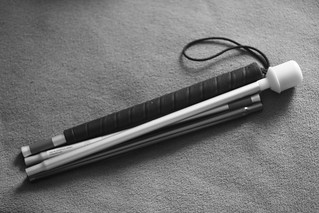Wednesday, October 31, 2018
Sunday, October 21, 2018
Saturday, October 20, 2018
Feeling the Way...

Travelling with my white cane…
Walking with a white cane is not as simple as you might think. It takes lots of practice to master it and to be able to travel independently and safely with it. First of all, you have to learn to hold the cane correctly. Then, there are different techniques that can be used to feel the way. Next is the ability to walk straight and to recognize the obstacles. When you can't see, you use your remaining senses for orientation. However, during mobility training you learn all these things, so you are able to travel around without any help.
The problem is the society. I know people often think that they are being helpful if they grab a blind person by the arm and drag them across the street, for example. But what if the blind person doesn't want to cross the street at all? The biggest problem is that such an action is a very scary experience for the blind person. Who just grabbed me? Where is this person taking me? Where am I? How do I find the right direction again? All of these things start rushing through your mind when you can't see what's going on. You lose your concentration, you become disoriented and it can be very difficult to find your bearings again.
So, here' the right way to help a blind person:
If you see a person travelling with a white cane and want to help them, approach them and ASK them if they need help. If they accept, they'll let you know how you can help them. However, if they refuse, don't feel offended. Blind people are perfectly capable of travelling around independently.
15th October: White Cane Safety Day

15th October is White Cane Safety Day. "The mission of White Cane Day is to educate the world about blindness and how the blind and visually impaired can live and work independently while giving back to their communities, to celebrate the abilities and successes achieved by blind people in a sighted world and to honor the many contributions being made by the blind and visually impaired. " (http://www.whitecaneday.org" rel="nofollow">www.whitecaneday.org
)
When you lose your sight, white cane becomes a big part of your life. It offers you independence and enables you to travel safely. While it looks simple, the white cane is actually quite a sophisticated tool. Firstly, it enables you to feel what's in front of you when you walk. Secondly, it alerts you to a change in the ground surface with sound (the tip of the cane makes different sounds when you drag it across different kinds of surfaces). Thirdly, it lets the people around you know that you're blind or partially sighted.
However, instead of embracing the chance of independence and safety offered by the white cane, many blind or visually impaired people feel embarrassed and refuse to use it. They prefer to rely on other people's help to get around. That is so unnecessary. White cane is a wonderful tool that gives you back some of the independence you had before losing sight.
And, finally, here's some information on my new white cane that you can see on the photo. I got it a few days ago and it's great! It's a folding cane, it folds into 4 parts (three parts are white and one is red). The handle is made of black rubber, which offers a very good and solid grip. The cane has a marshmallow tip, which spins around, offering good tactile and audio information about the ground surface. The tip is made of a sturdy material, which doesn't wear out easily, but can easily be replaced when it does. The cane itself is made of aluminum, which means that it is sturdy and light. A tough elastic connects the cane parts inside the cane. This means that I just have to grab the handle and let the rest of the cane "drop down" and the elastic makes the parts "jump" together and connect instantly so that the cane can be used immediately.
So, to sum things up:
If you suffer from sight loss or blindness, don't hesitate to talk to your doctor about the possibility of getting a white cane! You might have to go through a mobility training to learn to use the white cane correctly first, but after that you will be able to move around independently and safely. And that's the most important thing!



